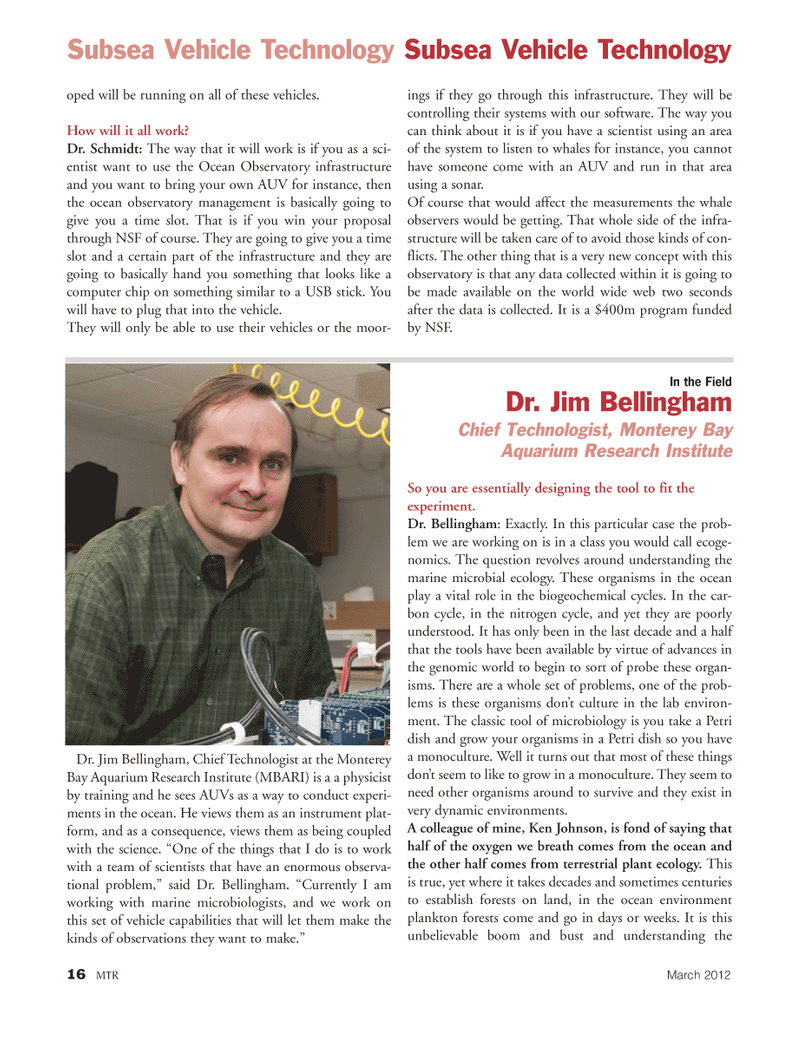
Page 16: of Marine Technology Magazine (March 2012)
Subsea Vehicle Report – Unmanned Underwater Systems
Read this page in Pdf, Flash or Html5 edition of March 2012 Marine Technology Magazine
16MTRMarch 2012 oped will be running on all of these vehicles. How will it all work? Dr. Schmidt: The way that it will work is if you as a sci- entist want to use the Ocean Observatory infrastructure and you want to bring your own AUV for instance, then the ocean observatory management is basically going to give you a time slot. That is if you win your proposal through NSF of course. They are going to give you a time slot and a certain part of the infrastructure and they are going to basically hand you something that looks like a computer chip on something similar to a USB stick. You will have to plug that into the vehicle. They will only be able to use their vehicles or the moor- ings if they go through this infrastructure. They will be controlling their systems with our software. The way you can think about it is if you have a scientist using an area of the system to listen to whales for instance, you cannot have someone come with an AUV and run in that area using a sonar. Of course that would affect the measurements the whale observers would be getting. That whole side of the infra- structure will be taken care of to avoid those kinds of con- flicts. The other thing that is a very new concept with this observatory is that any data collected within it is going to be made available on the world wide web two seconds after the data is collected. It is a $400m program funded by NSF. Subsea Vehicle Technology Subsea Vehicle Technology In the FieldDr. Jim Bellingham Chief Technologist, Monterey BayAquarium Research InstituteDr. Jim Bellingham, Chief Technologist at the Monterey Bay Aquarium Research Institute (MBARI) is a a physicist by training and he sees AUVs as a way to conduct experi- ments in the ocean. He views them as an instrument plat- form, and as a consequence, views them as being coupled with the science. ?One of the things that I do is to work with a team of scientists that have an enormous observa- tional problem,? said Dr. Bellingham. ?Currently I am working with marine microbiologists, and we work on this set of vehicle capabilities that will let them make the kinds of observations they want to make.? So you are essentially designing the tool to fit the experiment. Dr. Bellingham : Exactly. In this particular case the prob- lem we are working on is in a class you would call ecoge- nomics. The question revolves around understanding the marine microbial ecology. These organisms in the ocean play a vital role in the biogeochemical cycles. In the car- bon cycle, in the nitrogen cycle, and yet they are poorly understood. It has only been in the last decade and a half that the tools have been available by virtue of advances in the genomic world to begin to sort of probe these organ- isms. There are a whole set of problems, one of the prob- lems is these organisms don?t culture in the lab environ- ment. The classic tool of microbiology is you take a Petri dish and grow your organisms in a Petri dish so you have a monoculture. Well it turns out that most of these things don?t seem to like to grow in a monoculture. They seem to need other organisms around to survive and they exist in very dynamic environments. A colleague of mine, Ken Johnson, is fond of saying that half of the oxygen we breath comes from the ocean and the other half comes from terrestrial plant ecology. Thisis true, yet where it takes decades and sometimes centuries to establish forests on land, in the ocean environment plankton forests come and go in days or weeks. It is this unbelievable boom and bust and understanding the MTR#2 (1-17):MTR Layouts 2/21/2012 10:18 AM Page 16

 15
15

 17
17
